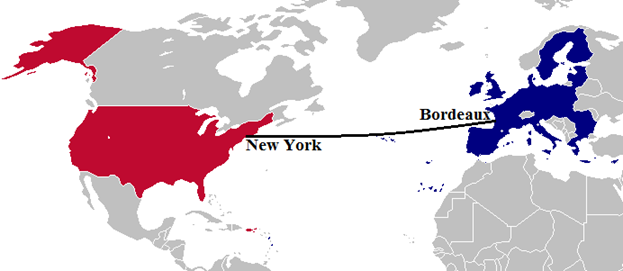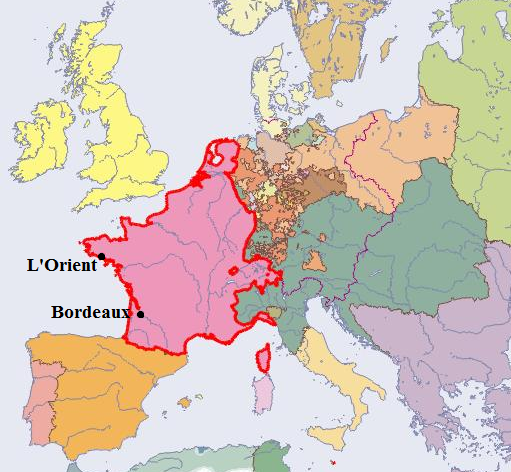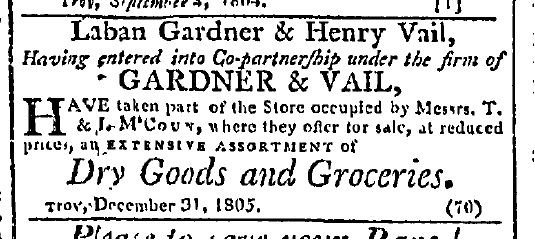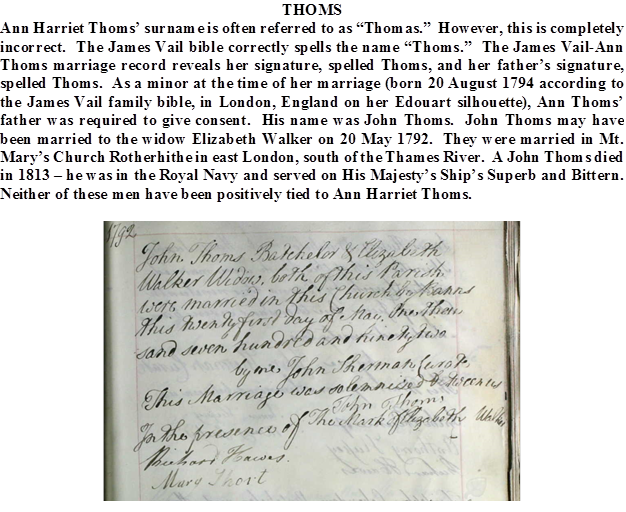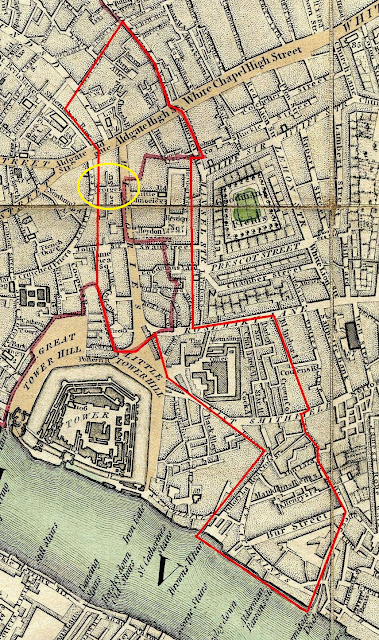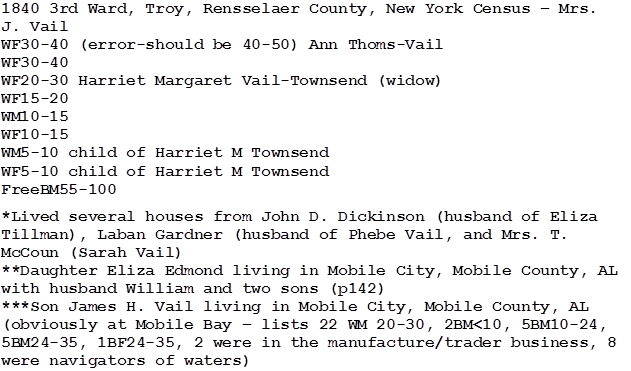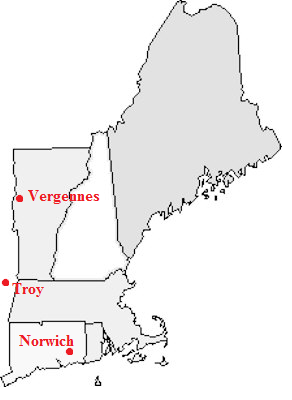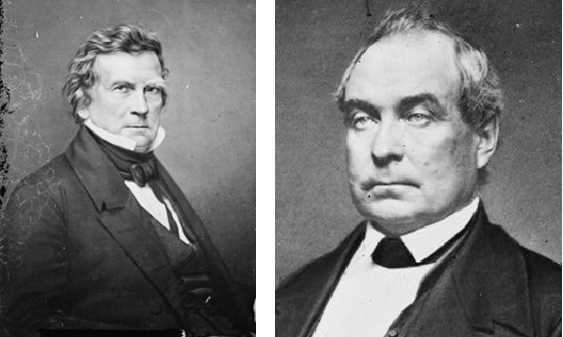The family of Aaron Vail and Martha
Ward Vail began with their marriage in Westchester County, New York about 1747 (no marriage record has been found). Their first child Lucretia Vail, was born on 26
October 1748 in Westchester County. On 6
April 1750, they had a son Moses Vail.
Sadly, this first Moses Vail died at about three months of age, in July
1750. The family moved north to the
Dutch community of Nine Partners, Dutchess County, New York about 1751 (Robert
Vail site, familytreemaker.com). Aaron and
Martha Vail decided to honor the memory of their deceased baby boy by naming
child number three (who was born 5 March 1753 in Nine Partners) Moses Vail. Note: I have seen 15 March 1753 but believe that date to be incorrect.
The Nine Partners Meetinghouse is
in current day Millbrook village, near the center of the Town of Washington. The old meetinghouse (actually the third
which was built about 1780) is located at the intersection of state highway 343
and Church Street.
Moses Vail grew up a Quaker – the
Aaron Vail family were members of the Society of Friends. Not only was he a Quaker, he later became the
son of a Quaker minister. His father
Aaron Vail was born a Presbyterian but in his youth, began to attend different
Quaker Societies. In about 1749 he found
the Society of Friends, became a member in 1753, and around 1764 became a
Quaker minister (Vail genealogy book). So,
Moses Vail grew up immersed in the Quaker culture.
The Vail family, like other
Society members, were interested in peaceful ideologies such as securing
freedom for oppressed Africans. Once in
Nine Partners, they attended the Nine Partners Meetinghouse, which had the
largest congregation in the Hudson Valley.
Normally a Quaker meetinghouse was located in rural undeveloped
locations but the Nine Partners Meetinghouse was in a more populated and
well-developed locale. The Nine Partners
patrons were also more prosperous than other Quakers.
When a young man of 21, Moses
Vail was present and served as a witness for his older sister Lucretia’s
marriage to Valentine Brown (4 April
1771) at the Nine Partners Meeting House, Dutchess County, New York. Just over two years later and at age 23,
Moses Vail met, courted, and married 18-year-old Phebe Holmes (born 10 July
1756). Phebe, the youngest of 10 children
(though four were already dead), was the daughter of Jonathan Holmes and Phebe
Haight Holmes. The Holmes family were from Charlotte, Dutchess County, New York, north of
Nine Partners. Moses and Phebe announced
their first intention, according to Society law, on 16 September 1774 and their
second intention on 21 October 1774.
Within a week after the second intention announcement, their marriage
had been solemnized (27 October 1774) at Nine Partners. At the time of the marriage, Moses Vail was
living in Charlotte where the Holmes family lived. The marriage was attended by:

Notice that Moses Vail's sister Lucretia Vail-Brown was not in attendance. She died in 1774, probably before this marriage, leaving her two year old daughter without a mother.
Charlotte (now Stanfordville) village
was about 5 miles north of Nine Partners (now Millbrook) village, in
present-day Rensselaer County (above). Shown also are town boundaries. Nine Partners was located in Washington Town,
adjoining Charlotte Town. Sarah
Vail-McCoun and Phebe Vail-Gardner were born in Nine Partners Village,
Washington Town, Rensselaer County (death record).
In 1775, war broke out between
the English and the American Colonies. Quakers
did not agree with war and generally avoided fighting and paying taxes that
supported the patriotic cause. Many
Quaker groups were severely disliked by patriotic Americans, and were often forcefully exiled. Moses Vail was found to have served
during this Revolutionary War but at what capacity is unknown (he was later recognized by the governor who stated Moses Vail “served his country well and is a deserving
character”). During the war years
(1775-1781), four children were born to Moses and Phebe Vail:
Sarah Vail – born 2 October 1775 in Nine
Partners
Phebe Vail – born 28 June 1777 in Nine
Partners
Martha Vail – born 26 January 1779 in Nine
Partners/New Stores
James Vail – born 16 November 1780 in Nine
Partners/New Stores
After the early war campaigns in
and around Boston, the British army landed in New York in July 1776. About a month before the British took New
York City, Moses Vail’s father Aaron Vail passed away on 11 August 1776 while
in the Charlotte Precinct. Prior to his
death, he had become active in public ministry and addressed the Quaker
communities in a “lively manner.” Aaron
Vail often claimed, near the end, that his “day’s work was nearly done.” He had also become very concerned that
Friends (Quakers) should spend their time in “the life of religion” so they
could “witness the ancient power to be their support.” By doing this, Aaron Vail believed people
would be able to “stand in times of trial” as he firmly believed “a time would
come when every foundation would be tried.”
Aaron Vail had actually suffered from a lingering sickness for several
years. During that time and anticipating
his demise, he was concerned that his wife and children should “live near the
Lord and know him to be their portion and the lot of their inheritance” and that
his children “might be preserved in love and tender affection to their mother
and one towards another” (Memorials Concerning Several Ministers and Others,
Deceased: Of the Society of Friends by S. Wood New York, 1814).
Just over a year after Aaron
Vail’s death, his widow Martha Ward Vail married secondly Joseph Irish of
Oblong, Dutchess County on 22 January 1778.
The Quaker church made an inquiry into her widowhood after she and her
intended husband made their first intention several months prior to their
marriage.
From Quaker church records, Moses
Vail appears to have moved his family during the Revolutionary War from
Dutchess County to Albany County (later Rensselaer County), New York about 1780
(this date also reported in History of Rensselaer County, NY). The move probably occurred in late 1780 after the birth
of fourth child James Vail in November 1780. Note: Dutchess County births record the first four
births in Dutchess county and then no others, if more were born there, I think they would have shown in the Dutchess County birth records.
Vail tradition appears to dispute the 1780 date. For one, Moses Vail may have moved to Albany County before 1779 as Martha Vail relatives report she was born in Albany County in January 1779 (though her birth record is found in Dutchess County, it is possible that they had moved and then returned to record the birth at their church). And also, Moses Vail may have moved to Albany County between 1784 and 1786, as relatives report sons Henry
(born 1782) and George (born 1784) were born in Dutchess County (their Oakwood Cemetery interment records completed at the time of their deaths). Note: An 1851 source reports descendants at that time gave 1786 as year of their move to New Stores. The Gazetteer of the State of New York by J. H. French states Moses Vail came just after 1786. Regardless of the move date, Moses and Phebe Vail remained connected to
Dutchess County throughout the 1780s, as evident by their recorded presence at family and neighbor marriages in Dutchess County.

Moses Vail moved his family about
1780 from Nine Partners to New Stores, Albany County
It appears that from the time they became connected to Albany County (approximately 1780), Moses and Phebe Vail added
five more children to the Vail clan, all boys. Note/reminder: At least two of those could have been born in Dutchess County (Oakwood Cemetery records):
Henry Vail – born 27 December 1782 in New
Stores/Nine Partners
George Vail – born 18 November 1784 in New
Stores/Nine Partners
Thomas Vail – born 10 July 1787 in New Stores
Moses Vail – born 29 December 1788 in New
Stores
Jonathan Vail – born 10 May 1791 in New
Stores
The children of Moses Vail
received a modest education, but their training was not considered to
be advanced (later Henry Vail stated he received limited schooling but the boys
obviously had more than a basic education).
Moses Vail lived in a small budding
Albany County town which soon became known as New Stores (in 1786). The settlement adopted the name New Stores when new businesses were erected that provided settlers in the area with better access to necessities. Formerly, area settlers were forced to travel to Schodack Landing (11 miles) or Albany (13 miles) for supplies. The "new stores" were erected at a rural crossroad. In the early 1780s, another road was built, connecting the crossroad with Schodack Landing. That road brought more traffic through the fledgling rural crossroad town with the new stores and would soon become a major thoroughfare to western New York .
Moses Vail's partner Jonathan Hoag, a Quaker neighbor from Nine
Partners, reported later that when he first visited this location in 1775,
the land was in a state of nature with one tavern (Thomas Hick Tavern) and one or two houses (including the Hugh Wilson home, information from A
Brief History of the Village of Nassau).
On 10 May 1786, Moses Vail and Jonathan Hoag purchased land at New Stores. On the following day, 11 May 1786, the business partners mortgaged 368 acres to Thomas Peach for 900 pounds. The initial payment was followed by monthly mortgage payments that continued for decades. The land Vail and Hoag purchased can be identified as a farm on a map drawn for Stephen Van Rensselaer by John Van Alen, surveyor, in 1787. The survey can also be found in the Schodack Surveys book and in the Van Rensselaer account books. By estimate, the land/farm encompasses half of present-day Nassau and is on the north side of Route 20 (from Some Information About Moses Vail).
The Moses Vail home at 31 Elm Street
Moses Vail and Jonathan Hoag partnered to build a store in the spring of
1786 (others state it was built some time between 1786 and 1790) on the corner of what is currently Church Street and Elm Street in Nassau
(New Stores became Union Village in 1798 and later Nassau about 1806). The store is known to have been a two story rectangle, painted red. At about the same time, Moses Vail built his
home a short distance away at 31 Elm Street (A Brief History of the Village of Nassau). Jonathan Hoag is thought to have only been a part time resident at New Stores. He was not officially discharged from his Dutchess County Meeting House until 1789 (other histories state he was not permanently at New Stores until 1792). At that point, he build his home just east of the Vail-Hoag store.
Moses Vail and Jonathan Hoag are
considered leaders in the early expansion of New Stores. They built stores and dammed the Valatie Kill
to form a source of water to power mills. The dammed pond overflowed north onto Joseph Primer's farm (who had lived on this land since 1760). In 1790, they purchased 228 acres from Primer (the south half of his farm). Their new tract surrounded Beaver Meadow. Records show that the monthly payment for Primer's land went to Stephen Van Rensselaer - 24 bushels of wheat per year. Note: Seems that Primer leased the land from Van Rensselaer and the lease for that portion was transferred to Vail and Hoag, from Some Information About Moses Vail. Also in 1790, Vail and Hoag purchased land to the west of New Stores along the Valatie Kill - part of the Martin Galer farm (the location then known as Martin's Kill). Note: records seem to indicate the Vail-Hoag partnership purchased more land.
New Stores was located in a larger area known as Rensselaerwyck, encompassing
the present-day Schodack on the Hudson River. According to the 1790 New York census, Moses Vail was living in
Rensselaerwyck, Albany County, New York near his brother Samuel Vail and friend Jonathan Hoag
(proximity of names on the census denotes habitat proximity). The New Stores village in the early days was
on a road that connected Albany, New York, to Boston, Massachusetts.
According to the 1790 census,
Moses Vail’s household was populated by more individuals than his known immediate
family members.
New Stores (today called Nassau) was in southern
Rensselaer County in 1791
In 1791, Albany County was
divided and a new county emerged – Rensselaer County. Moses Vail was among the Rensselaer County
men who became the first county officers.
They took the oath at the inn of Annais Piatt, also an original county justice, on 3
May 1791 during the first county court meeting (History of the City of Troy).
During the initial year of Rensselaer County’s existence, Moses Vail ran
and was elected in Rensselaer County to be an Assemblyman, or a county
representative, for the fifteenth New York State Legislative Assembly in 1791 (Political
graveyard, http://politicalgraveyard.com/bio/vail.html#RSG005V57, Landmarks of Rensselaer County says four
years as senator but that is not correct). In the first year of his political career (starting with the service as Justice), Moses Vail found himself with a one-year term which required him to
be present at Federal Hall in New York City from 5 January to 12 April
1792. The New York Governor at that time
was George Clinton, who was in his fifteenth year of service in that position.
The top
five candidates receiving votes were elected in the 1791 Rensselaer County election. Moses Vail finished fifth and was
elected (notice he won none of the precincts but was close in Stephentown). He had no established political
affiliation.
In February 1792, Phebe Holmes Vail took a trip, presumably to visit
her family in Nine Partners. She had
taken her youngest son Jonathan and possibly others. While gone, young Jonathan, only nine months
old, passed away (story related in the James Vail bible). His death would have been unknown to Moses,
who was either at home in New Stores or, more likely, in New York City serving
as an Assemblyman in the fifteenth New York Legislature.
On 25 June 1792, Moses Vail and Jonathan Hoag leased a 6.9 acre farm in East Manor from Stephen Van Rensselaer. Moses Vail would be connected to this lease for less than a month. The Moses Vail - Jonathan Hoag partnership dissolved in June/July 1792. History reports that Moses Vail removed himself from the union and for 100 pounds, sold his shared land rights to Hoag on 20 July 1792. The next month (13 August 1792), Stephen Van Rensselaer provided Hoag with a new lease for the former Vail-Hoag lands (information from The Early History of Nassau Village).
 Moses
Vail attended the Legislative Assembly in New York City during 1792 at Federal Hall where
George Washington first took the Oath of Office in April 1789, becoming the
first President of the United States.
The U. S. Capitol was moved from New York City to Philadelphia in 1790
where it remained until 1800.
Moses
Vail attended the Legislative Assembly in New York City during 1792 at Federal Hall where
George Washington first took the Oath of Office in April 1789, becoming the
first President of the United States.
The U. S. Capitol was moved from New York City to Philadelphia in 1790
where it remained until 1800.
Top
five elected in 1792 Rensselaer County election. Moses Vail finished seventh and was not
elected. He had no established political affiliation.
Later in 1792, another election took place to determine Rensselaer County Assemblymen for 1793. Moses Vail was again one of nine men who were on the ballot. He did not fare as well this year - he came in seventh and was defeated.
The year after the loss of his young child and the loss in the Assemblyman election,
Moses Vail’s wife Phebe passed away on 19 June 1793. Her death was said to have taken place in New
Stores (unknown source for date and place of death). It seems possible Phebe died during pregnancy
or due to complications with child birth since she was only 36 years old and
had her last child in 1791. Phebe Holmes-Vail's burial is assumed to have taken place in or near New Stores. She is thought to have been buried at Jonathan Hoag's Orchard Cemetery on Elm Street, not far from her home at 31 Elm Street.
Note: In or before the 1920s, her stone marker was removed. The cemetery had fallen into disarray by the 1920s and many/most of the stone markers were no longer present (from Some Information About Moses Vail). In 1964, the stone was found by Ralph Phillips (who owned the Moses Vail home at the time) lying face up and was being used as a doorstep into a garage at the Moses Vail home (from Some Information About Moses Vail and A Brief Guide to the Buildings and History of Nassau Village). That stone was placed at Nassau-Schodack Cemetery, less than a mile south of Nassau (by Ralph Phillips). The same stone may still be one currently at that cemetery. Some feel that the stone found in 1964 may have been replaced by a new one to honor both Phebe and Moses. Note: from findagrave.com, states she died in 1795, obviously a misread of the stone which reads that she died 19 June 1793 - and could be misread as a 1795 - and was age 36 years, 11 months. Note: The stone at the cemetery looks to have been created at the death of Moses Vail. Maybe it was taken and altered after 1815 and the plan was to move both graves together - but never happened.
Within the next year (1793 or 1794, according to sources), Moses Vail moved
his family north to Troy, also in Rensselaer County (Rensselaer County history
book). At Troy, Moses Vail erected a
flour mill on the Poesten Kill in 1794 between Mount Ida Falls and the land of Mahlon
Taylor (Rensselaer County history book, Landmarks of Rensselaer County by Anderson).
Mahlon Taylor, a millwright, had purchased land from the original Dutch
owners who had previously built a dam on the Poesten Kill. Taylor had restored the dam and then erected, in 1792,
a large flour mill and saw mill. The saw
mill allowed newcomers to the area access to lumber for building homes and
businesses. A second flour mill was reportedly
built shortly after Taylor’s mills and just upstream near Ida Falls – the mill
of Moses Vail (History of the City of Troy).
Note: It seems odd that Moses Vail would lose his wife in New Stores June 1793, pack his family and move to Troy without a wife, and then marry in Troy August 1794 (see below). There must be more to that story - Did his first wife actually die in Troy? Had he and his first wife moved to Troy before her death, and then her burial was at New Stores? Was he matched with his second wife in some way and moved to Troy to live with her?
On 11 August 1794, Moses Vail married secondly to Lucy Tracy-Tillman in Lansingburgh, Rensselaer County, which was a small village adjoining Troy to the north (marriage record from 1793-1864 First Presbyterian Church, City of Troy Marriage Records). Lucy Tracy-Tillman had been living as a widow since 1790 when she was found as a resident of Rensselaerwyck, Albany County in the 1790 New York Census. Lucy Tracy had married Christopher Tillman on 9 July 1776 in Schaghticoke, Albany County, which adjoined Lansingburgh and was later annexed. She was a member of the Dutch Reformed Church and had five children who were baptized in that religion (Shaghticoke Church records). Christopher Tillman was a Lansingburgh militia captain early in the Revolutionary War and was later a merchant in Albany and Lansingburgh. From 1774 to 1790, he had been involved with the development of Lansingburgh and was town clerk and trustee until the year of his death in 1790. He died 17 May 1790 and may have been buried in the Lansingburgh Village Cemetery (a new headstone was placed there in 2015 but no previous stone is known to have existed). Lucy Tracy-Tillman operated an inn in Lansingburgh after her husband’s death (History of Rensselaer County, NY).
Lucy Tillman had five children with her first husband. Their births were between 1776 and 1790. Those children joined a large number of Moses Vail children. Since the newly weds were still relatively young, Lucy Vail about 40 years old and Moses Vail just 41, they unsurprisingly had at least two known children together. William Townsend Vail was born in 1796, baptized in 1798, and then died in 1798. As was Quaker tradition, their second child was a son and was named for their deceased first child. William Ward Vail was born by 1798 (from The Early History of Nassau Village). No further information about either of these children has been located. Note: The middle names of these sons may have come from Vail associations. Moses Vail’s oldest daughter married Townsend McCoun a few years before the birth of William Townsend Vail. Additionally, Moses Vail’s mother was born Martha Ward which could account for the name William Ward Vail.
An interesting question to consider is whether, during his adult life, Moses Vail maintained the Quaker affiliation he was raised in during his youth. His religion during adulthood is not currently known. However, his children were not recorded in any known Quaker Church records. And ultimately, he appears to have married a woman that was of the Dutch Reformed Church…not a Quaker. There is absolutely no evidence to tie him to the Quakers after 1784.

Troy in 1794 Rensselaer County
The west border of Rensselaer
County is formed by the Hudson River.
The Poesten Kill meets the Hudson, flowing east to west, at the village
of Troy. Mount Ida Falls is located in
the middle of the village of Troy.
As a merchant by profession in Troy, Moses Vail came into contact with
many of those citizens who were settling the Troy village and surrounding town. His peers stated “[Moses Vail was] a man of
high political standing, and that he possessed a strong hold upon the popular
heart of the country” (History of Rensselaer Co, NY by Sylvester, pub
1880). By early 1796, Moses Vail
decided he had gained popular support and ran once again for political
office. This time he was added to the ballot
as a potential State Senator from the Eastern District. The top five in the election would represent
the Eastern District of New York (Clinton, Columbia, Rensselaer, and Washington
Counties) in the New York State Legislative Assembly, now meeting in
Albany. Moses Vail ran as a member of
the Federalist Party, the election taking place 26 April through 28 April. The Federalist Party members swept the
election as Moses Vail came in fourth after the votes were tallied. He drew a three year term. Federalist Party members swept most of the
political campaigns during this era.
Federalists followed New York politician Alexander Hamilton’s fiscal
policies and were committed to a fiscally sound and nationalistic
government. Though President George Washington,
in the last year of his presidency, leaned toward the Federalist platform, he
was an independent. Federalist John
Adams won the presidency during the election of 1796 by a narrow margin over
Republican Thomas Jefferson – 71 to 68 in electoral votes – and would take over
in 1797.

Top
five elected in 1796 Eastern District election.
Moses Vail finished fourth and was elected as a New York State Senator. Notice the Moses Vail was the election for Rensselaer County and nearly won for Clinton County.
Soon after his marriage in August
1796, Moses Vail traveled to New York City to serve at the 20th Legislative
Assembly during the 1 November to 11 November session and then after the new
year from 3 January to 3 April 1797.
According to the Military Minutes of the New York State Council of Appointments, Moses Vail received a commission to be captain in the Dutchess County military. In 1797, Moses Vail was the captain of one of the eight companies in Lieutenant Colonel Benjamin Noxon's Regiment - a regiment within Brigadier General Samuel Augustus Barker's Brigade (there was at least one other brigade in Dutchess County). Lieutenant Colonel Noxon had previously been the captain of a Dutchess County company (called the Beekman Company) during the Revolutionary War.
The
Old Albany City Hall where the New York legislature met starting in 1797 (left)
and New York Governor John Jay who served 1795-1801 (right)
Moses Vail was in Albany at the
Albany City Hall for the 21st Legislative Assembly. The session ran 2 January to 6 April
1798. During the session on 8 January,
Moses Vail was voted by his Legislative Assembly peers to be on the New York
State Council of Appointment. He was the
Eastern District representative on the Council with New York Governor John Jay,
who was re-elected in 1798, and three other voted members – William Thompson,
Ezra L’Hommedieu, and Joseph White. The
Council of Appointment was a one-year term. The Council had the power to appoint all state,
county, and municipal officers within the state of New York, including State
Comptroller, Secretary of State, Attorney General, Surveyor General,
Chancellor, New York Supreme Justices, sheriffs, district attorneys, judges,
surrogates, city and county clerks, mayors, all military officers and many
more.
Voting
results for 1798 New York State Assembly Council of Appointment
After Moses Vail returned to Troy
in 1798, he and others started the Troy village fire department and he served
as one of the fire wardens (Landmarks of Rensselaer County NY). Note: He would also serve as fire warden once again
in 1801.
At the end of his three year term
as Senator of New York, Moses Vail ran once again to be re-elected. The Federalist Party made a strong show in
1799 as the voting followed the party affiliation connected with President John
Adams. Moses Vail finished second in the
Eastern District voting, now encompassing seven counties. His term would be four years. This election would be one of the last
dominated by the Federalist Party.
Top
five elected in 1799 Eastern District election.
Moses Vail finished second and was elected as a New York State Senator. Over
30 others received votes.
John
Dean Dickinson, Yale graduate, lawyer from Lansingburgh, New York, US House of
Representatives 1819-1823 and 1827-1831.
He married Moses Vail’s daughter-in-law Ann Eliza Tillman in 1793.
On 11 November 1801, New York
Governor John Jay, along with the New York Council of Appointment, appointed
Moses Vail sheriff of Rensselaer County. Note: Other records state he was sheriff also in 1800. Moses Vail’s last Legislative session, during the 24th Assembly, was at
Albany from 27 January to 8 April 1801.
He retired as New York Senator which left an opening for an Eastern
District representative.
The third US President Thomas
Jefferson, elected 1800, served 1801-1805
After a short respite, Moses Vail decided to run once again for New
York Senator in 1803 as an Eastern District candidate. As in previous elections, the voting followed
the popular political affiliation. Republicans dominated the voting which
followed the Presidential election of 1800 in which Republicans Thomas
Jefferson and Aaron Burr (the top two vote-getters were made President and Vice President) received the popular vote though Congress was still a
Federalist majority. A Republican also
won the 1801 New York Governor election - George Clinton defeated Federalist
John Jay.
Top
five elected in 1803 Eastern District election.
Moses Vail finished ninth and was not elected as a New York State
Senator.
Moses Vail departed on a voyage
to see his brother Aaron Vail, the United States Consul
at L’Orient, France, during the summer of 1803 after his loss in the New York
Senate election. Moses Vail had
previously sent his son James Vail to France, probably before 1800. James Vail had become Aaron Vail’s private
secretary and lived in the Aaron Vail L’Orient home. In a letter to his brother Samuel Vail (a
merchant in Albany), Moses Vail wrote of his France trip to visit his younger
brother Aaron Vail. The letter was
written in L’Orient, France on 20 October 1803. Note: I have not seen the letter but relate the content below as it is found on
Robert Vail’s website (http://familytreemaker.genealogy.com/users/v/a/i/Robert-S-Vail-iii/GENE1-0019.html):
Moses Vail says he arrived in L’Orient on 9 August 1803 after a
long, disagreeable passage part of which was stormy and boisterous. After being
at sea for five weeks an American ship from Dunkirk gave them word of France
and England being at war "which was unpleasant news, and about 2 weeks
after (this) we were taken by a British privateer, to wit on the fourth of July
and carried first into Saint Marys a port in one of the Rocky Isles of Scilly,
from thence to Falmouth, a Town on the English Channel in the South of England,
having been at sea near eight weeks. But our stay here was but short, the
Officers of the Privateer found on their arrival they could not make a prize of
us were glad to be clear of us by paying our Captain some Damages; from whence
we put to sea and arrived at Bordeaux in France in six days, from whence I
traveled by land to this Place…”
"After crossing a ferry about a mile from this City, I was overjoyed, (although)
a dark night to hear my Brother’s Voice on the ferry stairs, enquiring if there
was not an American in the Courier. When I alighted I found him with his wife
and several of their children who had been waiting for me through the
Evening." They resided in the Summer House "till within a few days we
have moved within the walls of the city."
"I have had only ten days with Aaron as he has been at Paris settling some
business with Government, but expect his return soon. I was very unfortunate
not to see James (Moses Vail son) who left Bordeaux for America about 10 days
before my arrival at that place. I hope he has visited you before this but fear
his business has led him to the West Indies.
"Aaron is well settled here, has an amiable wife & seven children…I
have wrote to George (Moses Vail son) and most of my children…Give my love to
Siche & the children, aqnd to our good mother when thee sees her or writes
to her. I hope my return will be before long. May heaven protect you all. I am with affection thy brother. M. Vail"
Moses Vail probably left the New
York port and landed in Bordeaux, France in 1803, a one-way trip that was over
3,600 miles.
France borders in 1803
After Moses Vail’s return to America from France, the pace of his life
began to slow. He did not run for many other political offices, though he
became the village Assessor in Rensselaer County in 1809 for the first ward of
Troy (History of The City of Troy). His
son James Vail remained in France throughout the first decade of the 1800s. Sons Henry and George Vail started a
mercantile business in Troy about 1806 (both not found in 1810 census). Son Thomas Vail married near 1810 (1810
Rensselaer County census head of household with a wife). Moses Vail and his son Moses were living with son-in-law and daughter Francis and Martha Yvonnet (and her children, Moses Vail's grandchildren) in 1810.
1810 Troy,
Rensselaer County, New York State Census - F. Yvonett
WM26-45
Francis Yvonnet
WF26-45
Martha Vail-Yvonnet (31)
WF10-16
Martha Yvonnet (c10)
WM0-10
Francis Yvonnet
WM0-10
George Yvonnet
WM0-10
Lawrence Yvonnet
WM>45
Moses Vail (57)
WM16-26
Moses Vail (22)
Moses Vail’s grandmother Martha Ward-Vail-Irish died 21 February 1812 in her 88th year while living in Albany, New York. Though he moved often in his early days, Moses Vail had remained in Troy, New York since 1794, going on 20 years. On 5 June 1815, Moses Vail passed away at the age of 62 years (Necrology List found in History of The City of Troy). His obituary appeared in the Troy Post newspaper on 13 June 1815 where he was said to have died "in this village on Monday the fifth." Hence he was in Troy at the time of his death. Further information states he was “interred in a burying ground nearby.” Family records indicate he was buried on the hill east of the city (Troy). However, there are no records of any burials at this location. Other records state that his remains and other Vails were moved to the Oakwood Cemetery plot belonging to son George Vail soon after George Vail purchased it in 1851. A marker identifying Moses Vail, noted earlier, is in the Nassau and Schodack Cemetery. Since the gravestone inscription for Phebe Vail and Moses Vail looks like it was made at the same time, the Vail family must have had the stone made at the time or after Moses Vail's death. It is unknown if Phebe Vail was actually buried there or if the stone simply acknowledges her death 22 years before at New Stores. The stone states that Moses Vail “died 5 June 1815, aged 61 years" (the photo of the stone is not readable and I have not seen the stone to verify).
Note: His second wife Lucy Vail was still alive at the time of Moses Vail's death. She died over 11 years after Moses Vail in Lansingburgh on 18 September 1826.
The Nassau and Schodack Cemetery
in southern Rensselaer County where Moses Vail and his first wife Phebe Holmes
Vail are buried.





















